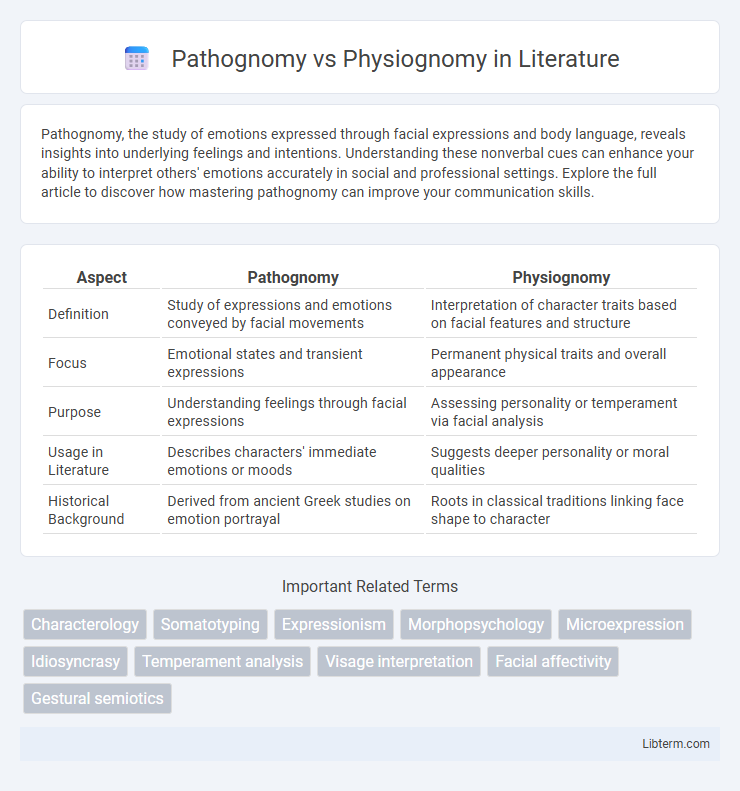Pathognomy, the study of emotions expressed through facial expressions and body language, reveals insights into underlying feelings and intentions. Understanding these nonverbal cues can enhance your ability to interpret others' emotions accurately in social and professional settings. Explore the full article to discover how mastering pathognomy can improve your communication skills.
Table of Comparison
| Aspect | Pathognomy | Physiognomy |
|---|---|---|
| Definition | Study of expressions and emotions conveyed by facial movements | Interpretation of character traits based on facial features and structure |
| Focus | Emotional states and transient expressions | Permanent physical traits and overall appearance |
| Purpose | Understanding feelings through facial expressions | Assessing personality or temperament via facial analysis |
| Usage in Literature | Describes characters' immediate emotions or moods | Suggests deeper personality or moral qualities |
| Historical Background | Derived from ancient Greek studies on emotion portrayal | Roots in classical traditions linking face shape to character |
Introduction to Pathognomy and Physiognomy
Pathognomy studies the expression of emotions and mental states through facial movements and gestures, emphasizing the dynamic aspect of human nonverbal communication. Physiognomy analyzes static facial features and structures to infer character traits or personality, relying on the physical appearance of the face. Both disciplines provide insights into human behavior but differ in their approach: pathognomy focuses on emotional expression, while physiognomy centers on unchanging facial characteristics.
Defining Pathognomy: Emotions on Display
Pathognomy focuses on the study and interpretation of emotions expressed through facial expressions and bodily gestures, highlighting how feelings are visibly displayed. Unlike physiognomy, which assesses character traits based on facial features, pathognomy deciphers immediate emotional states and reactions. This discipline plays a crucial role in psychology and nonverbal communication by revealing underlying emotional experiences through observable physical cues.
Understanding Physiognomy: The Face as Identity
Physiognomy studies the face as a reflection of personality traits and identity, analyzing features such as eye shape, cheekbones, and jawline to infer character or emotions. This discipline, rooted in psychology and anthropology, emphasizes the biological and social signals conveyed by facial expressions and structures. Unlike pathognomy, which focuses on emotions and their fleeting expressions, physiognomy examines more stable facial characteristics that contribute to individual identity and social perception.
Historical Origins and Evolution
Pathognomy and physiognomy both originated in ancient Greece, with physiognomy dating back to Aristotle's works on assessing character through facial features, while pathognomy emerged later as the study of interpreting emotions and inner states based on expressions. Throughout the Renaissance, physiognomy evolved into a pseudo-scientific discipline used in criminology and personality assessment, whereas pathognomy influenced early psychology by focusing on transient emotional cues. Modern research distinguishes physiognomy's focus on static physical features from pathognomy's dynamic analysis of emotional expressions, reflecting their divergent historical trajectories and applications.
Scientific Foundations and Criticisms
Pathognomy studies the scientific analysis of facial expressions and emotional states grounded in neurobiological mechanisms, whereas physiognomy interprets character traits from static facial features, lacking empirical validation. Modern neuroscience supports pathognomy through measurable correlations between muscle movements and specific emotions, while physiognomy faces criticism for its pseudoscientific basis and ethical concerns. Skepticism towards physiognomy arises from its reliance on subjective judgment and absence of replicable data, contrasting with pathognomy's foundation in observable physiological responses.
Key Differences: Pathognomy vs Physiognomy
Pathognomy examines facial expressions and body language to interpret emotions and psychological states, emphasizing transient expressions. Physiognomy assesses static facial features and structures to infer personality traits or character, often assuming more permanent attributes. The key difference lies in pathognomy's focus on dynamic emotional cues versus physiognomy's emphasis on fixed physical characteristics.
Notable Figures and Influential Works
Notable figures in pathognomy include Charles Le Brun, who extensively studied human facial expressions as emotional indicators, while Johann Kaspar Lavater is a key figure in physiognomy, known for his seminal work "Physiognomische Fragmente" that linked facial features to character traits. Influential works in pathognomy also feature Duchenne de Boulogne's experiments with facial muscles, advancing the scientific understanding of emotional expressions. In contrast, physiognomy's influence waned due to its pseudoscientific basis, but Lavater's writings remained culturally significant in the 18th century.
Pathognomy and Physiognomy in Modern Psychology
Pathognomy studies the expression of emotions through facial and bodily expressions, emphasizing real-time emotional states in modern psychology. Physiognomy analyzes static facial features to infer personality traits or character, a practice now largely discredited but influencing early psychological assessments. Contemporary psychology values pathognomy for understanding nonverbal communication and emotional recognition in clinical and social contexts.
Ethical Considerations and Misconceptions
Pathognomy, the study of expressions linked to emotions, often risks ethical concerns when used to infer inner feelings without consent, potentially leading to privacy violations. Physiognomy, which assesses personality traits based on facial features, is widely criticized for its pseudoscientific basis and historical misuse in promoting racial and social biases. Both practices face ethical scrutiny due to their potential to reinforce stereotypes and make unfounded judgments about individuals.
Conclusion: Contemporary Relevance and Future Directions
Pathognomy examines facial expressions to interpret emotions, while physiognomy assesses physical facial features to infer personality traits, with both fields facing scientific criticism but maintaining cultural significance. Contemporary research integrates pathognomy into affective computing and psychological diagnostics, enhancing emotion recognition technologies. Future directions emphasize interdisciplinary approaches combining neuroscience, artificial intelligence, and psychology to improve accuracy and ethical application in social and clinical settings.
Pathognomy Infographic

 libterm.com
libterm.com